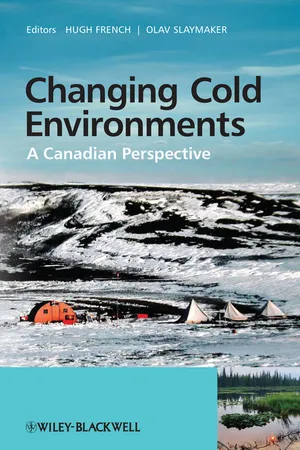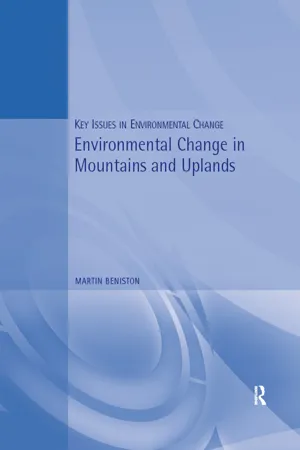Geography
Cold Environments
Cold environments refer to regions characterized by low temperatures, typically found at high latitudes or altitudes. These areas are often covered in snow and ice, with permafrost being a common feature. Cold environments have unique ecosystems adapted to the extreme conditions, and they play a crucial role in regulating the Earth's climate system. Human activities in these regions can have significant environmental impacts.
Written by Perlego with AI-assistance
Related key terms
4 Key excerpts on "Cold Environments"
- eBook - ePub
Changing Cold Environments
A Canadian Perspective
- Hugh M. French, Olav Slaymaker(Authors)
- 2011(Publication Date)
- Wiley-Blackwell(Publisher)
Part One Spatial and Temporal Variability of Canada's Cold EnvironmentsPassage contains an image Chapter 1 Cold Canada and the Changing Cryosphere
Hugh French1 and Olav Slaymaker21 University of Ottawa2 University of British Columbia, Vancouver1.1 IntroductionIn a series of major reports, first initiated in 1990, the United Nations Intergovernmental Panel on Climate Change (IPCC) has been assessing the nature, impact and implications of current global climate change. The latest report (IPCC, 2007) concluded that warming of the climate system is unequivocal. A global temperature increase of about 0.2 °C per decade is projected for the coming two decades. It has also become clear that the cryospheric components of the climate system are closely linked to this global warming. Moreover, Canada, along with Russia and Greenland, shares the majority of the northern cryosphere.The general thrust of the 2007 IPCC report, namely, that the Earth's climate is changing with negative consequences, has led to publication of a counter-document by the Nongovernmental International Panel on Climate Change (NIPCC), a non-profit research and educational organization based in the USA. This report (Singer and Idso, 2009) challenges the scientific basis behind the concerns that global warming is either man-made or would have harmful effects. It is argued that twentieth century warming has been moderate and, in fact, is not unprecedented.We do not wish to enter this global minefield; we leave that to others. Instead, the aim of this book is to simply document the changing nature of Canada's Cold Environments and, by implication, outline the possible global impacts. We restrict the broader discussion to the northern hemisphere.1.2 The CryosphereThe main components of the cryosphere are snow, river and lake ice, sea ice, glaciers and ice caps, ice shelves and ice sheets, and frozen ground (Figure 1.1 - eBook - ePub
- Andrew Palmer, Ken Croasdale(Authors)
- 2012(Publication Date)
- WSPC(Publisher)
Chapter TwoThe Physical and Biological Environment
2.1 Climate
The Arctic covers a vast area, and has many diverse environments. Almost every physical environment found in other parts of the world can also be identified in the Arctic, where there are high mountains and featureless plains, deserts and rolling hills, cliffs, great rivers and huge deltas. It would make no more sense to think of a single undifferentiated ‘Arctic’ Environment' than it would to think of a single ‘tropical’ Environment.One factor is climate, and climate too is diverse. Table 2.1 lists a series of Arctic places, and the temperature and wind at each place on December 8 2008 (morning in the eastern hemisphere, evening in the western hemisphere). Obviously another day and another year would be different, and the table is no more than a snapshot that does not replace the detailed and careful statistical work carried out by climatologists. Websites [1 ,2 ] give almost immediate information. Recall that the distances are immense: at 60°N, 10 degrees of longitude correspond to 556 km on the ground going east or west, so that many of these places are thousands of km apart.Several striking features emerge. The northernmost places are not the coldest. Oymyakon is below the Arctic Circle, far to the south of many places along the Arctic Ocean coast, but it has the lowest temperature in the list, and is reputedly the coldest continuously-inhabited place in the world, a distinction it took over from Verkhoyansk when its weather station was moved to the airport, which lies in a frost hollow. The diamond-mining centre of Mirnyi has almost as low a temperature.Pevek in Chukhotka is further north but much warmer. Similarly in Alaska, Fairbanks too is below the Arctic Circle, but its temperature is lower than Barrow on the Arctic Ocean. Places like Mirnyi and Fairbanks have continental climates with warm summers and extremely cold winters, whereas near the ocean the climate is moderated by the ocean, which has a large thermal inertia and can relatively exchange heat with the air. - eBook - ePub
- Simon Catling, Tessa Willy(Authors)
- 2018(Publication Date)
- SAGE Publications Ltd(Publisher)
environmental geography. These aspects of geography have a long history – for instance, when regional geography was a dominant approach in school geography in the first half of the twentieth century, regions were discussed in terms of their physical geography, including rivers, lakes, plains, mountains, valleys, ecology and geology, and their human geography, such as types of industry, products, trade, settlements, commerce and ways of life. However, they were rarely considered in terms of environmental geography – for instance, how people have changed the landscape over time, human impact on climate, extracting resources, deforestation and pollution. Understanding physical, human and environmental geography is important to understand our planet, our lives and their incontrovertible interrelationships. This is the focus of this chapter, but we begin by noting briefly the geological context in which we live.Living in a geological epoch
The interrelationship between the physical environment and human activities is argued to have become much greater in recent centuries. It is contended that humans have had such an impact on the natural environment that we should have a new name for the current geological time in which we live and that this name should be the Anthropocene (Hamilton et al., 2015; Goudie and Viles, 2016; Bonneuil and Fressoz, 2017). The term ‘Anthropocene’ is being used to identify a ‘new’ geological epoch (Schwägerl, 2014; McNeill and Engelke, 2014). Its purpose is to reinforce just how significant humans have become in affecting the physical environment of the Earth. We have done this, it is argued, through our actions, such as deforestation, energy extraction and generation, mobility and travel, urbanisation and industrial practices (Goudie, 2013; Holden, 2012; Whitehead, 2014; Goudie and Viles, 2016; Kress and Stine, 2017). Such developments have led to changes in our vegetation, land cover, oceans, atmosphere and climate, and weather systems and patterns. One impact is described in the term ‘climate change’ and debated in relation to the warming of the Earth’s atmospheric and ocean temperatures (Maslin, 2014). This is having the effect of heating our planet at a much faster rate than has hitherto happened, hence the use of the phrase ‘global warming’ (Maslin, 2014). The Earth’s climate has constantly changed; the difference today is that it is happening, in geological terms, very quickly, and that it appears already to be affecting our environments and lives very seriously through such events as higher temperatures and increased and heavier rainfall, resulting in such effects as the increased frequency and severity of storms, flooding, drought and wildfires (Core Writing Team et al - eBook - ePub
- Martin Beniston(Author)
- 2016(Publication Date)
- Routledge(Publisher)
2 Characterization of mountain environments 2.0 Chapter summaryThis chapter provides an overview of different aspects of physical and human systems in mountain regions as they are perceived today. There is a strong bias towards climate and atmospheric processes, because climate is one of the dominant environmental controls on natural systems in mountains. Climate determines to a large degree the amount and timing of runoff in the main hydrological basins of the world; it plays a key role in snow and ice formation; and it exerts a major influence on the distribution of plant species and ecosystems, both altitudinally and latitudinally. The major interactions between mountains and climate, from the global down to the local scales, are reviewed; there is a subsequent overview of specific issues related to mountain hydrology, cryosphere, soils and vegetation, as well as the interlinks between all these systems.Problems related to the human presence in mountains and uplands, in both the developed and the developing world, are discussed towards the end of the chapter. Issues of health, tourism and resource use are also addressed. Distinctions are made for the level of economic activity taking place in different mountain regions of the world, as well as the environmental impacts which these imply.2.1 ClimateClimate is the principal factor governing the natural environment on short time scales (as against plate tectonics, which is responsible for the formation of mountains). Climate characterizes the location and intensity of biological, physical and chemical processes. It is for this reason that a large part of the present chapter will be devoted to the climatic component of the environment. Mountain climates consist of four major factors (Barry, 1994), which will be addressed in the following subsections, namely:• continentality • latitude • altitude • topography. 2.1.1 ContinentalityContinentality refers to the proximity of a particular region to an ocean. The diurnal and annual ranges of temperatures in a maritime climate are markedly less than in regions far removed from the oceans; this is essentially due to the large thermal capacity of the sea, which warms and cools far less rapidly than land. Because the ocean represents a large source of moisture, there is also more precipitation in a maritime climate than in a continental one, provided the dominant wind direction is onshore. Examples of maritime mountain climates include the Cascade Ranges in Oregon and Washington States of the USA, the Alaskan coastal mountains, the New Zealand Alps, the Norwegian Alps and the southern Chilean Andes. Mountains under the dominant influence of continentaltype climates include the Tibetan Plateau, the mountains of Central Asia (Pamir, Tien Shan, the Urals) and the Rocky Mountains in Colorado, Wyoming and Montana. However, many other mountain regions often define and separate climatic regions; for example, the European Alps act as a boundary between Mediterranean-type climates and Atlantic and continental climates to the north.
Learn about this page
Index pages curate the most relevant extracts from our library of academic textbooks. They’ve been created using an in-house natural language model (NLM), each adding context and meaning to key research topics.



